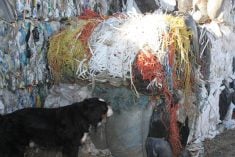The window for winter wheat seeding is quickly closing in Manitoba, while producers struggle with a delayed harvest caused by the wet spring.
“It doesn’t look good this year for getting a lot of winter wheat in the ground,” said Doug Martin, former chair of Manitoba Winter Cereals and currently with the Manitoba Crop Alliance.
Martin said a fair amount of canola remains to be harvested on fields typically seeded to winter wheat, and that likely means many producers will be unable to seed it.
Read Also

Message to provincial agriculture ministers: focus on international trade
International trade stakeholders said securing markets in the face of increasing protectionism should be the key priority for Canada’s agriculture ministers.
Less than a quarter of Manitoba’s canola crop has been harvested so far, according to the province’s latest summary. Northwest and central regions are furthest ahead of average.
The southwest, eastern and Interlake regions have seen about 15 percent of the canola crop harvested.
If producers can get fall rye or winter wheat seeded, conditions are favourable, according to the Manitoba crop report.
Some fields in Manitoba received 700 millimetres of rain over the growing season, Martin estimated, and early moisture delayed spring seeding.
“With the wet conditions and late crops, even the diehard guys are not getting any in this year. It’s just a lot of factors that are pushing against the crop,” he said.
As for this year’s winter wheat harvest in the Keystone province, Martin said things went well.
But it’s been a challenging crop for Manitoba producers over the last few years.
“A lot of it has to do with the winterkill — harder winters and springs that go on forever with the freeze-thaw effect that does a lot of damage,” said Martin. He also said he saw snow mould on his crop for the first time ever, which degraded his quality.
The recommended seeding window for winter wheat runs until near the end of September.
While some of the ecological and spread-out workload benefits of winter wheat might be lost for Manitoba producers, Martin said the financial hit of not getting in a crop this year won’t be too bad.
Martin said the differential price between winter and spring varieties is narrowing and there was a lot of room in elevators ready to take this year’s harvest of winter wheat following last year’s drought.
“This year, it’s just up against a wall. I like to have some early crops to start harvesting earlier. It spreads out your harvest, workload and cash flow,” he said. “Cash flow is a big thing because winter wheat was ready about two weeks before spring wheat this year because spring wheat was seeded late.”
Ontario is expected to continue to lead the way in winter wheat production this year followed by Alberta and Saskatchewan.
















